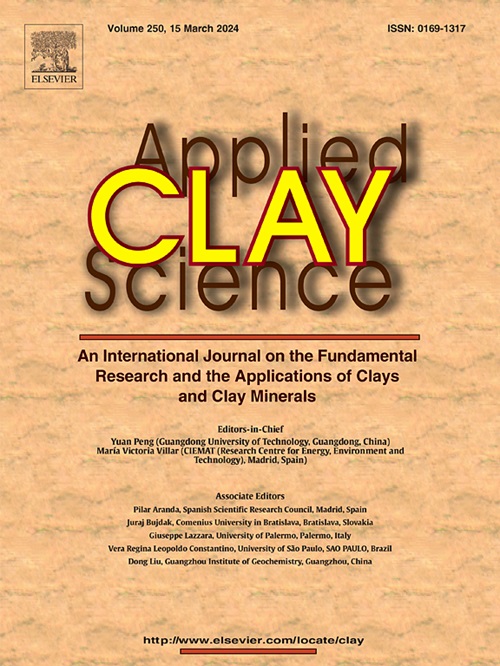Multifunctional nanocomposites based on kaolinite/titania/iron applied to hydrogen peroxide production and bisphenol–A removal
IF 5.3
2区 地球科学
Q2 CHEMISTRY, PHYSICAL
引用次数: 0
Abstract
The rising global demand for hydrogen peroxide, recognized for its eco–friendly properties, underscores the need for greener synthesis methods. Traditional production processes pose environmental risks, while direct synthesis faces challenges like water formation, explosion hazards, and stability issues, limiting industrial application. On the other hand, Bisphenol A (BPA), an endocrine disruptor widely used in plastics, presents significant environmental and health concerns due to its potential leaching into food and water. The present work introduces efficient and selective photocatalysts aimed at sustainable hydrogen peroxide synthesis and BPA degradation. Both processes were enhanced by the synergistic properties of Fe2O3–TiO2 nanoparticles dispersed within a kaolinite matrix. The Fe2O3–TiO2 photocatalysts, characterized by photoluminescence spectroscopy and X–ray diffraction, showed reduced emission upon iron incorporation and anatase presence on the kaolinite surface. The photocatalytic activity was evaluated through hydroxylation of terephthalic acid, revealing a 127 μmol/L min hydroxylation rate for the KaFeTi400 sample. BPA degradation studies indicated optimal performance in acidic conditions, achieving 96 % removal in 2 h and 98 % in 4 h, with the addition of H2O2 enhancing efficiency. Further, the photocatalyst facilitated benzyl alcohol oxidation to benzaldehyde, demonstrating a H2O2 production rate of 120 μmol. These findings highlight the multifunctional capabilities and environmental benefits of the photocatalyst, underscoring its potential for sustainable hydrogen peroxide synthesis and broader applications in environmental remediation. The catalysts address the pressing challenges associated with hydrogen peroxide synthesis and pollutant removal, particularly in the context of sustainability and environmental impact.

基于高岭石/钛/铁的多功能纳米复合材料在过氧化氢生产和双酚 A 去除中的应用
双氧水具有环保特性,全球对双氧水的需求不断增长,这凸显了对更环保合成方法的需求。传统的生产工艺存在环境风险,而直接合成则面临着水形成、爆炸危险和稳定性问题等挑战,从而限制了工业应用。另一方面,双酚 A(BPA)是一种广泛应用于塑料中的内分泌干扰物,由于可能会渗入食物和水中,因此引起了严重的环境和健康问题。本研究介绍了高效且具有选择性的光催化剂,旨在实现可持续的过氧化氢合成和双酚 A 降解。分散在高岭石基质中的 Fe2O3-TiO2 纳米粒子的协同特性增强了这两个过程。通过光致发光光谱和 X 射线衍射对 Fe2O3-TiO2 光催化剂进行了表征,结果表明,在高岭石表面掺入铁和锐钛矿后,发射率降低。通过对对苯二甲酸的羟基化来评估光催化活性,结果显示 KaFeTi400 样品的羟基化率为 127 μmol/L min。双酚 A 降解研究表明,该催化剂在酸性条件下具有最佳性能,2 小时内的去除率达到 96%,4 小时内达到 98%,加入 H2O2 可提高效率。此外,这种光催化剂还能促进苯甲醇氧化成苯甲醛,其 H2O2 生成率为 120 μmol。这些发现凸显了光催化剂的多功能性和环境效益,强调了它在可持续过氧化氢合成和更广泛的环境修复应用方面的潜力。这些催化剂解决了与过氧化氢合成和污染物去除相关的紧迫挑战,特别是在可持续发展和环境影响方面。
本文章由计算机程序翻译,如有差异,请以英文原文为准。
求助全文
约1分钟内获得全文
求助全文
来源期刊

Applied Clay Science
地学-矿物学
CiteScore
10.30
自引率
10.70%
发文量
289
审稿时长
39 days
期刊介绍:
Applied Clay Science aims to be an international journal attracting high quality scientific papers on clays and clay minerals, including research papers, reviews, and technical notes. The journal covers typical subjects of Fundamental and Applied Clay Science such as:
• Synthesis and purification
• Structural, crystallographic and mineralogical properties of clays and clay minerals
• Thermal properties of clays and clay minerals
• Physico-chemical properties including i) surface and interface properties; ii) thermodynamic properties; iii) mechanical properties
• Interaction with water, with polar and apolar molecules
• Colloidal properties and rheology
• Adsorption, Intercalation, Ionic exchange
• Genesis and deposits of clay minerals
• Geology and geochemistry of clays
• Modification of clays and clay minerals properties by thermal and physical treatments
• Modification by chemical treatments with organic and inorganic molecules(organoclays, pillared clays)
• Modification by biological microorganisms. etc...
 求助内容:
求助内容: 应助结果提醒方式:
应助结果提醒方式:


